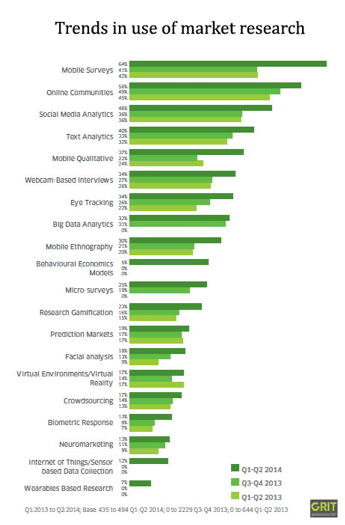What is mobile market research? Why is it growing so fast?
Co-authored with Andy Favell
The rapid growth in the use of mobile technologies, particularly the use of smartphones and tablets, has had a dramatic effect on market research. So much so that mobile market research (MMR) is now used by the majority (64%) of market research organizations surveyed for the latest GreenBook Research Industry Trends Report (GRIT) report. But is this business leading consumer or visa versa? It seems that one-fifth of consumers are already using mobile to fill out online surveys, despite the fact that most online surveys are not mobile-friendly.
1) What is mobile market research?
MMR uses wireless technologies – such as smartphones and tablets – to determine consumer opinions. These might include soliciting consumer reactions to companies and their products and services. mCordis defines MMR as: “connecting, measuring and engaging consumers with and through mobile.”
2) Why is it important?
The proliferation of mobile devices – at the end of 2013 there were 7 billion mobile subscriptions worldwide, according to the ITU, if divided fairly, that would be one for everyone on the planet – this gives market research companies the potential to reach more people than any other type of media. Moreover, the rapid improvement in the capabilities of mobile devices, better reliability of mobile networks and greater availability of data-inclusive (i.e. web access) subscriptions, makes this a very viable channel for conducting market research.
3) How big is it?

The use of mobile by research companies has grown rapidly over the last year. Mobile surveys are now used by 64% of the companies surveyed in the latest GRIT report (these were mostly mobile research companies) and being considered by a further 26%. In addition, mobile qualitative research, which records consumer behavior, rather than opinions, is used by 37% and mobile ethnography research, which studies cultural attitudes, is used by 30%.
10% of respondents identified mobile as the thing that would most impact market research, only topped by technology at 14% and big data at 16%.
4) Do people want to do surveys on mobile devices?
Market research is most commonly conducted online, but 19% of consumers fill out surveys on a mobile device, rather than a PC or laptop, according to consumer segment of the GRIT report. Notably, researchers are failing to match consumer demand – because only 5% of all surveys are actively programmed to be fit for mobile. So, for example, survey questions might not fit on the device screen, meaning the respondent has to scroll horizontally to read each one, or oversized images might mean web pages download slowly.
5) What types of mobile market research are there?
MMR takes many forms, including:
- Surveys – the respondent is given a number of questions, typically answered by multiple choice or giving a rating on a scale of 1-10. It’s similar to the Q&As used offline and online the world over, but the surveys should be shorter and the questions more concise than in other media and should use a format that is designed to be answered on a mobile device.
- Diaries – here a participant records their activities and opinions related to a certain topic e.g. what they eat, or how they shop. Ideally, with mobile diaries, text-based responses are kept to a minimum, using photographs, video and voice recording, where possible.
- Metering – the consumer opts in to allow an application to passively record their behavior. Typically this will be measuring how the mobile device is used: registering which websites are visited, applications used, advertisements seen/interacted with, coupons collected and redeemed; but metering can use mobile’s extensive portfolio of functions and sensors, and the fact that cell phones are taken virtually everywhere by consumers, to record real-world behavior such as where people go during the day, how active they are or how fast they drive.
- Discussion – using social media, such as web forums, instant messaging and video conferencing, groups of respondents can document and discuss their reactions to a product/service/company, under the guidance/watch of a marketer. This is mobile’s version of the focus group.
- One-to-one – rather than face-to-face interview, the respondent engages in a real-time (interactive) Q&A session, using SMS, chat, voice, video etc, where the next question is determined by the answer to the last, and what’s known about the participant.
6) How do/will brands/marketers use mobile market research?
There is a progression with MMR:
- Stage 1 – expand online research programs to ensure that people can answer them on their device of choice, when and where they wish – e.g. when they have ten minutes to spare on the train home.
- Stage 2 – design surveys to maximize the user experience on mobile devices, for example using question types that work well with touch interaction, so instead of asking a question that requires an input of 1-10 or hate/don’t like/like/love, the respondent pulls a slider across the screen to the right point. The beauty is that designing surveys for mobile devices, will usually deliver an improved experience on a PC also – shorter, to-the-point surveys, with visually appealing, interactive, concise questions will appeal to desktop or smartphone user alike.
- Stage 3 – going mobile only, perhaps smartphone or tablet only, unlocks a wealth of opportunities unavailable on a PC. Most obvious of these is location, allowing marketers to conduct research at the relevant time and place – e.g. soliciting reactions to products while shopping in-store; gauging opinions of a program or advertisement, while watching TV show; measuring customer experience when in a restaurant; or attitudes to public transport, when riding the bus.
Today most MMR is focused on stage 1.
7) What’s different about mobile?
The key to success is to respect the platform:
- Be aware of its limitations – the smaller screen size, the tediousness of text entry, the unreliability and cost of mobile connections, and poor battery life of many models should all be taken into account.
- Consider the relationship between user and device – it is more personal than a PC and can reveal much more about a person, with huge implications for both privacy and data protection.
- Play to its strengths – many devices have touch screens, are location-aware, have sensors that detect movement and direction; they can access the web, take pictures, record video and aid navigation; they connect with vehicles and wearable devices and sync with PCs; they can communicate in myriad ways: voice, video call, SMS, USSD, email, instant messaging and post to social media sites; they are always on, always with us, and most importantly virtually all of your customers will have one.
8) What are the rules?
Before starting on MMR, all companies should study the following documents:
- ESOMAR Guideline for Conducting Mobile Market Research
- Mobile Research Guidelines (Global Research Business Network, GRBN)
- Best Practices in Mobile Survey Design (WBA Research)
- Sample: Our Commitment to You as a Research Participant (Mobile Marketing Research Association, MMRA)
- Key Requirements for Mobile Research (MMRA)
- Mobile research glossary
Title Image by Pexels from Pixabay
Michael Becker is an intentionally recognized identity & personal information management solutions strategic advisor, speaker, entrepreneur, and academic. He advises companies on personal information economy business strategy, product development, business development, and sales & marketing strategies. He also represents them at leading trade groups, including the Mobile Ecosystem Forum. Michael is an advisor to Assurant, Predii, Privowny, and Phoji. He is the co-author of Mobile Marketing for Dummies and a number of other books and articles related to mobile marketing, identity, and personal information management. He is on the faculty of marketing of the Association of National Advertisers and National University. A serial entrepreneur, Michael founded Identity Praxis, co-founded mCordis and The Connected Marketer Institute, was a founding member of the Mobile Marketing Association (MMA), and was on the MMA board of directors for ten years and was MMA’s North American Managing Director for three years. In 2004, Michael co-founded iLoop Mobile, a leading messaging solutions provider. In 2014, Michael was awarded the 2014 Marketing EDGE Edward Mayer Education Leadership Award for his commitment to marketing education.

